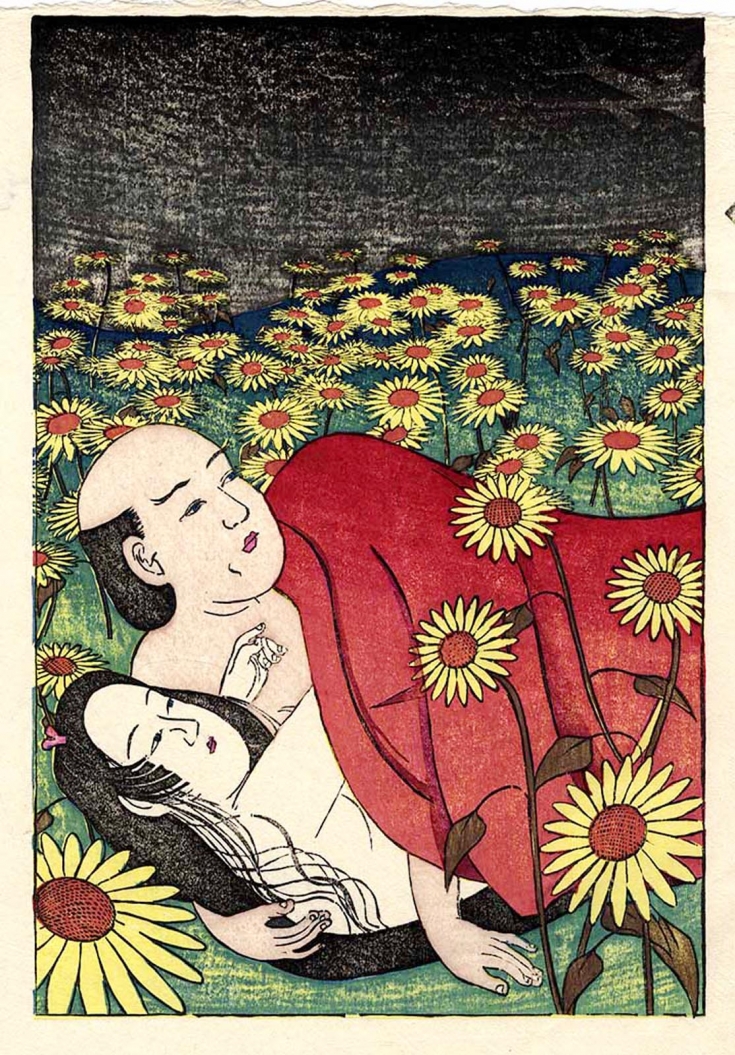Lovers in a field of daisies are interrupted by the passage of a jet as it flies into the picture’s border.
The title, “Pushing up Daisies”, was suggested by a friend, Jerry Vegder. Jerry called the morning of Sept 11 with awful news about a plane crashing into the World Trade Center. While we talked, he narrated as he watched live news coverage which accidentally caught the second jet as it flew into the tower. Millions of bright yellow daisies grow like crazy all over the Midwest in September. They signal the end of summer. Thousands suffered, trapped by fire until the towers collapsed.

“Pushing Up Daisies, Nov 2001, oban 15 x 10 inches, woodcut from 11 blocks, 17 printings, 72 sheets printed on nishinouchi paper
Our temporary world.
This fleeting moment.
Lovers interrupted.
A threatening sky.Daisies bloom uninhibitedly
wild under September sun.
Fields and road-sides yellow-dipped,
Jet thunder precedes the storm.
Printed using traditional Japanese hanga technique.
- I made the design and planned how to print it.
- I copied the design onto eleven blocks of wood. Each block intended to print a different color.
- I used knives and chisels to carve away the parts of each block which weren’t supposed to print.
I printed 72 sheets (not including two sets of half a dozen proofs each made in order to settle on the final colors and printing order).
- For each printing pass (I made 16 or 17 passes in all for each sheet – over 1,000 impressions total – produced entirely by hand!)
- water color pigment is brushed very smooth and thin onto the block along with a bit of rice paste. Control over dampness is the single most important printing skill.
- Then the (limp and damp) paper is carefully laid onto the block
- Finally, the back of the paper is rubbed with a ‘baren’ (pronounced bah-DEN – it’s a thin disk about 3 ½ or 4″ in diameter which is covered in bamboo-skin and kept lightly coated with Camelia Oil so it doesn’t abrade the paper) — rubbed with some real elbow grease so that the color is pressed deeply into the paper, or rubbed lightly so the color stand up on top, or rubbed on edge so the baren itself makes a mark into the image.
For this print, I used four colors: sumi; quinacidrone magenta; prussian blue; and transparent yellow. In all but two passes (the pale brown of his flesh and the olive of the leaves and stems), I used the colors un-mixed, achieving the final colors like the blue/green background, red coat, orange daisy centers by printing several colors over one another.
The paper is a very fine, hand made paper from Japan called Nishinouchi. It took two and a half twelve hour days to complete the run of 72 impressions.
After printing, the damp paper is interleaved with matboard and pressed flat to dry.
The prints has been collected by the following:
Gregory Robison, Nancy Patton Wilson, Kathy Chvojka, John Center, Julio Rodriguez, Jeanne Norman Chase, Carole Baker, Liz Horton, Josephine Severn, Barbara Mason, Gillyin Gatto, Maria Arango, Ruth Leaf, Wanda Robertson, Sylvia Taylor, Michelle Morrell, Akemi Ohira, Bea Gold, Dan Dew, Jim Bryant, Brian Lockyear, Richard Stockham, Murilo Pereira, Georga Garside, Jean Eger Womack, Mary Krieger, Princess Rashid, Angela Oates, Claude Aimée Villeneuve, E.B.Atwood, Barbara Patera, Barbara Mason, Sharen Linder, Michelle Morelle, Marilynn Smith, Maria Arango, Bill Wimmer, Teryle Blustein, Liz Horton, Wanda Robertson, Carole Baker, Gillyin Gatto, Jerry Vegder, Salomon Alfie, Lee & Joanne Lyon, Rolf Degener, Gene & Saurine Brown, Tsutomu Ohshima, John Teramoto, Ruthann Oelsner, KCAI — Anonymous donor to Twin Towers Orphan’s Fund, Dr. Sean Green